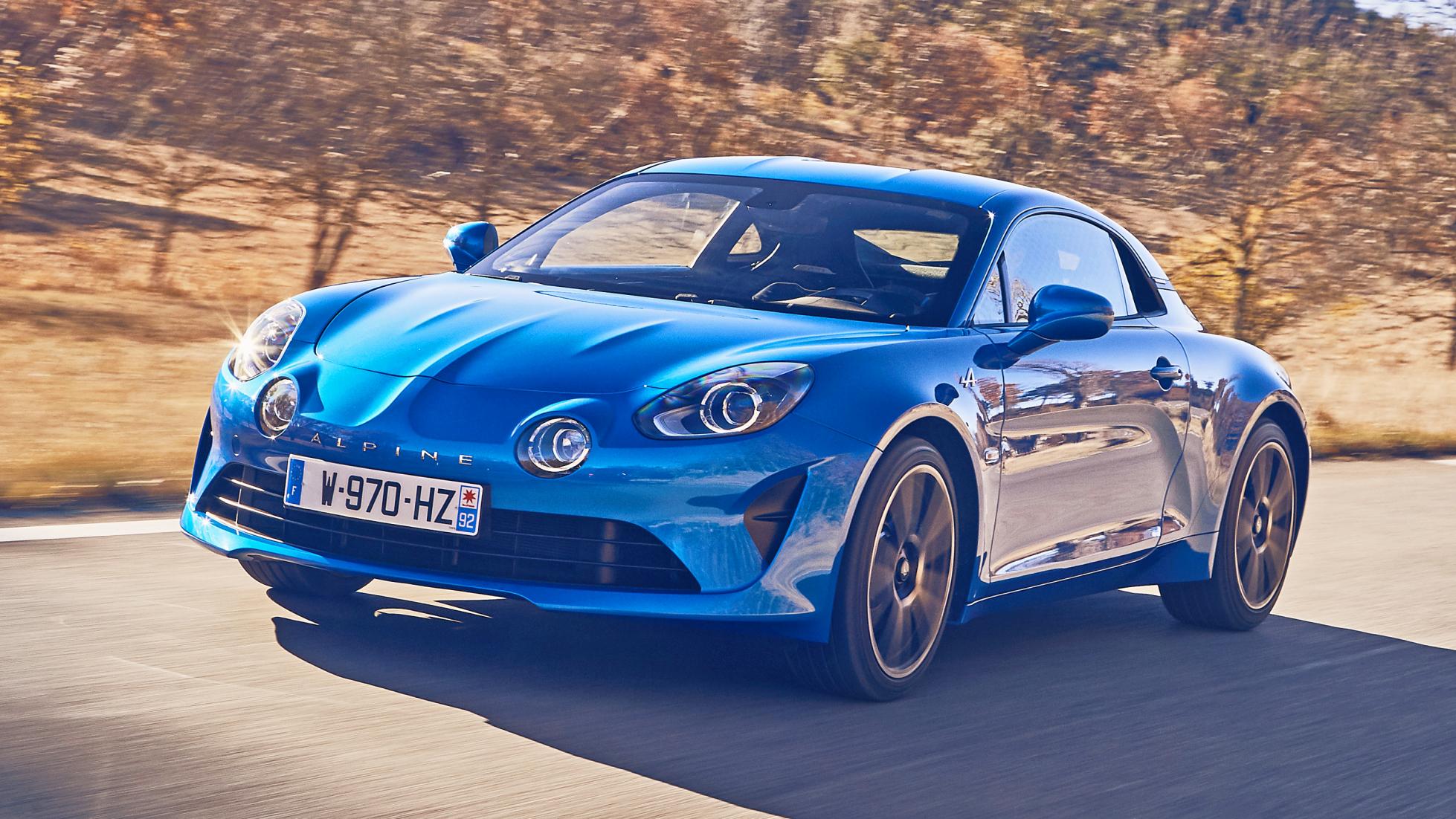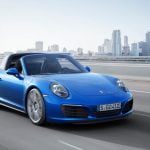
FOR:
A genuinely different rival to the Cayman, and a fine advert for light weight
AGAINST:
Its approach may be too dedicated for some
Overview
What is it?
It’s the new Renault Alpine A110. And it’s something very different. On the surface it’s perfectly straightforward, a compact two-seat coupe in the mould of the Porsche Cayman and Audi TT. But underneath the new A110 is perhaps the world’s best example of the virtuous circle approach to automotive engineering.
It’s light. Really light. Lotus light, yet with the creature comforts you need to make it a pleasing daily driver. How light? Just 1,103kg for the flagship version. That’s 300kg less than the Porsche or Audi – almost 25 per cent less, in fact.
How? Firstly by designing it from the ground up with little carryover, and secondly by sweating the small things. So it’s an aluminium bodied, aluminium chassis’d, aluminium suspended sports car that has a modest 1.8-litre turbocharged four cylinder engine developing 249bhp and 236lb ft of torque at 2000rpm. That’s mounted behind the seats and drives the rear wheels via a seven-speed Getrag double clutch gearbox – perhaps the only thing about the car that’s not the lightest possible option.
“We have tried to follow Colin Chapman’s principle, which is still valid, so if we have low mass, we can have moderate power, so we don’t need super wide tyres or big, heavy brakes and so on,” says Alpine’s chassis technical leader, Thierry Annequin, “we have chased all grams everywhere on each component and each system to achieve this weight.”
Everywhere you look you see this attention to detail. There’s no secondary brake caliper for the electric parking brake, it’s now integrated into the primary brake itself. That saves 2.5kg. And getting Brembo to integrate their software into the Bosch ECU instead of bolting on a separate control unit and wiring has saved another kilo. And the brackets that hold the parking brake’s cables and hoses are aluminium too. “This is unusual”, claims Annequin, “but it saves seven grams 12 grams there, and it adds up.”
The Sabelt seat is a mere 13.1kg – half the weight of the Recaro seat in the current Megane RS. The message from Alpine, building its first car since the final A610 rolled out the Dieppe gates 22 years ago, is that light weight matters.
It certainly promises to make the Alpine efficient – the claims are 46.3mpg and under 138g/km of CO2, numbers a standard Cayman can’t get within 7mpg and 30g/km of.
Driving
What is it like on the road?

Quick confession: the car I drove was a pre-production example, but Renault claims that dynamically it was 100 per cent representative. We’ll update this review when I drive the full production car on the December 7.
Let’s start with the drawbacks, as there are some interesting points to be made here. Because it’s light, it gets buffeted around a little bit. You notice it on motorways, not only from crosswinds, but from the surface itself. A car that weighs just 1,103kg (and that’s in maxed out Premiere Edition spec) and has the majority of that at the back (the weight distribution is 44:56), does dance a little on truck ruts and occasionally needs a guiding hand on a blustery day.
The engine isn’t particularly charismatic. The 1.8-litre four cylinder turbois shared with the new Renaultsport Megane (albeit with its own specific air intake, turbo, exhaust system and engine tune), and is pleasant enough to use, sounds crisp and provides swift, easy pace. It also avoids the trap the four cylinder Cayman has fallen into by mistaking volume for character.
Nor does it fall into the same trap as the Audi TT and mistake grip for handling. The Alpine (pronounce it Al-peen, not Al-pine, it is French after all…) is a car that treads more lightly than its German opposition, and kicks back against current trends. You’ll search in vain for an adaptive suspension button, for instance. Underneath it uses double wishbone suspension at both ends. It’s rear-wheel drive, through a twin-clutch gearbox.
Do yourself a favour and switch straight out of Normal once you get moving. This is the nearest the A110 gets to an eco mode and in it the seven-speed transmission shuffles up through the gears, the engine is more muted and the throttle more muffled. It’s too calm.
Sport sharpens up the engine and gearbox, steering, stability control, exhaust and even dashboard display. Track mode simply unhooks the ESC some more (it can be fully disabled, too).
Sport is where the Alpine A110 shows its true colours. It flows beautifully. This is a sports car done differently. It’s not hard, nor harsh, aggressive, or intimidating. Instead it’s simply wonderfully composed and fluid. No matter how awkward the road surface underneath, the Alpine, with little weight to compress its soft springs, glides across the ruts and bumps. The ride quality and control is bewitching – like a Lotus, but with longer suspension travel and greater refinement.
It’s almost languid, a car that always has time to respond, that seems in fact to slow time down. There is some roll, and Alpine hasn’t followed fashion by fitting super-direct steering. Instead the whole car seems carefully tuned to itself, all components working in harmony. The steering is accurate, not super-light, but gives you a good idea of what the chassis is up to, the ride is flattering, on B-roads the whole car seems to slip through the air easily, unflustered and untroubled (it’s only at high speeds in straight lines you notice the buffeting).
The one exception to this performance is the brakes, which have astonishing bite and power. They look modest, the 320mm discs, but when you’ve only got a tonne or so to stop…
Is it a shame there’s no manual gearbox? Possibly. The twin clutch is way better here than in the RS Clio, but it’s not the snappiest shifter about. Like the engine, it’s not especially memorable.
The key here is that the Alpine feels different. Hard to say whether this makes it better or worse than a Cayman, but certainly on paper the smaller numbers make less impression (until you reach the ones mentioning mpg and CO2). But in reality, it’s very convincing. It would be good if the gearbox was sharper and the engine had more spark, but the way it goes down the road, the fluidity, the delicacy, the adjustability and accuracy all makes the Cayman feel borderline clumsy. Just in case you want the numbers to hand the Porsche (295bhp, 1,410kg, 5.1secs to 62mph) has a power to weight ratio of 210bhp/tonne, while the Alpine (249bhp, 1,103kg, 4.5secs to 62mph) has 226bhp/tonne. Don’t doubt the A110’s speed. It just doesn’t feel particularly fast because it never seems to have to work that hard.
This is Alpine sailing against the prevailing winds. On track you are aware that its modest tyres don’t have as much outright grip as some, that its responses are less aggressive, that it’s a more placid car. And some buyers might not like that. But others will love it. At least you now have a choice.
On the inside
Layout, finish and space

The cabin gets close to being as appealing as the Cayman’s or TT’s. The design is lovely, but what lets it down – and then only slightly – is the quality and materials. They’re not bad, but the leather isn’t quite as tactile, the steering wheel is slightly bulbous and the infotainment graphics ought to be more vivid. This does mean the 58,500 euro asking price for the Premiere Edition models looks awfully steep (further pricing is yet to be announced).
But as a car to drive, the A110’s interior sets the tone very nicely indeed. The optional fixed Sabelt seats not only look superb, but are superbly shaped and yet weigh only 13kg each – half the weight of the Recaro seats fitted in Renault’s hot hatches. You sit low, and rear visibility isn’t great, but because the car is small, the driving position good, the controls well weighted and accurate, you have confidence on narrow roads. It’s a gap-slipper par excellence.
The centre console bridge features a pouch for your phone as well as the gearchange buttons and USB socket, there’s storage on the level underneath, plus a brace plate for the passenger. There is Renault switchgear, but so different is the layout and design that you’re only peripherally aware of it.
Owning
Running costs and reliability

They come only in blue, black or white, with 18-inch Fuchs forged aluminium wheels, active sports exhaust, a Focal audio system (that’s very impressive), quilted leather seats and a plaque on the console. Let’s guess as entry-level Alpine will be about £40,000 basic. An Audi TTS starts at £40,840, a Cayman at £42,897.
Care about fuel economy and CO2? Against those two the A110 makes a compelling proposition. The Cayman (38.2mpg and 168g/km of CO2) and TTS (40.9mpg and 159g/km) fall well short of the 46.3mpg and 138g/km the A110 achieves. We’ve run both Cayman and TTS on the fleet at Top Gear and know they return about 28-32mpg. We’ll assume the Alpine will do around 36-37mpg. It’s a useful advantage, but not a revolution.
It’s a car that’ll turn some buyers on, and just as effectively turn others off. For some it won’t wear the right badge or convey the right impression, others will reject it because the power and torque figures appear modest. They just don’t get it and never will. My advice? Make sure what you want is what the Alpine offers, and not just a bid to own something different to a TT or Cayman.
Verdict
Final thoughts and pick of the range
It tackles difficult roads with unflappable poise and agility, it’s a non-threatening sports car that proves that you can reverse the trend towards bigger wheels, bigger brakes, more power and more weight and still have a capable and exciting sports car. There’s not much that flows across country with so little effort and so little energy expended.
Will it be a success? I sincerely hope so, but above that I hope it will be influential, will show other marques that nothing’s changed and weight saving still matters and can be achieved. As we embark on the era of electric cars with their heavy battery packs, that seems curiously important.
[“Source-topgear”]





